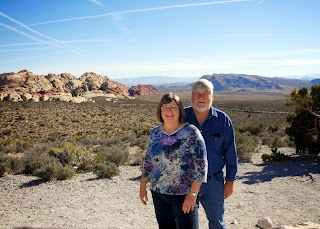I apologize for the delay in postings. This Spring has been hectic - we were temporarily living in Missouri again (Dennis worked for a couple of months there) and then we headed out for a few weeks of travel. We are now back in Indiana and plan on enjoying some of the local festivals and attractions for the summer.
While in Missouri, Lizz and I decided to take a few days for a trip to Oklahoma. We had heard about digging Selenite crystals and thought this would be an interesting outing. Dennis was unable to go due to his work schedule. If you would like to visit this area - google Jet, Oklahoma and see just where we were. I had never heard of the Salt Plains or a salt lake in Oklahoma before our research to take this trip. Not much information is out there, so hopefully this blog might help a few folks deciding to explore the area.
 |
| Entrance onto the Salt Plain - the dig site is one mile out |
We camped at the state park on the lake. They have RV spots and tent sites, a restroom with showers and all sites have water available. Prices are reasonable and the park was clean. We camped in April and there were plenty of spaces available - the summer could be crowded, this seems like a place where many local people swim and fish. The only problem we encountered was the lack of instructions or staff. Most parks we have been to have a gate, ranger or at least an instruction board. We drove around 2 of the camp areas without ever finding anyone. The visitor center was closed (even though the sign stated they were open for another hour). The campsites weren't marked, so we just chose one we liked and set up camp. A couple hours later a ranger drove by and we were able to pay for our camping. He took my name and money, but didn't ask for ID or our car plate number. No issues with camping (besides it was really windy at times) and there were trash dumpsters and privies close by. We camped along the spillway from the dam and a ways from the showers, so we drove there.
Make sure you bring everything you need - no camp store is close by. The town of Jet is less than 10 miles and has a small convenience store if you forgot something. The town of Cherokee is about 20 miles and there is a grocery store, hardware, motel and a few dining establishments.
Stop by the visitor center at the Great Salt Plains State Park for information about the area and also a sheet about digging crystals. They will give you a crystal point to get your collection started!
There are NO facilities on the digging site. Restrooms are available at the gate area where you drive out onto the flats, but it is a mile out to the dig site. The first impression we had was that of the book/movie 'Holes'. Big, flat, open area with holes dug here and there. There are markers to follow - you must dig within the marked areas. The crystals reform so the sites are rotated yearly so there are always a fresh supply. The size of the crystals depends on the water flow during the previous years. Wet times can actually dissolve some of the crystal and too dry can mean not much growth. Digging is free - you can collect 10# per person, per day.
Like previously stated - bring EVERYTHING you will need. The basics should include - a sturdy shovel, container for your crystals (foam container, ziploc bags, small boxes), water - LOTS of water for digging, washing crystals and drinking, extra clothes, sunblock, snacks, camera....did I mention water?!

There are NO instructions that actually show you how this is done. It was a learning experience for us and most of the others we encountered. Use your shovel to dig a hole - you will hear a 'crunch' as crystals are broken. Once you have a hole, use your fingers and water to loosen the sand on the sides of the hole to expose the crystals. Sometimes your water will stay in the hole and you can splash it on the sides, other times it will absorb into the bottom so more water is needed. We found if there was more clay in the hole the water would stay....but the formations were small and few. The looser sand places seemed to have more crystals, but it is the luck of the draw. We spent an day on the area and ended up with quite a few nice specimens.

The prize crystal is the flat blade, clear double terminated point with the 'hourglass' sand inclusion. This is the only place in the world that these can be found. The crystals are fragile when wet, so put them in a box or tray to dry in the sun once you have rinsed them to dry. Some of the clusters just fall apart when you try to clean them - you will end up with multiple small points. We gently rinsed a few that stayed together and then sprayed them with a matte sealer when dry to help hold them together.
We had one great dig day, then the weather turned cold the second day and it made digging not much fun. Winter coats were needed and our hands were freezing after a short time. Summer can be brutally hot on the Salt Plain, so plan accordingly. The dig site is open April 1 through October 15 though the access to the site may be impassable if there is rain.






















































